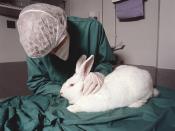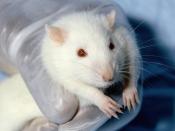Animal Testing
Since 2002, over 1 million animals that the USDA collects numbers on, which includes dogs, cats, sheep, hamsters, guinea pigs, and primates, have been tested on. Since then, that number has increased to approximately 1.4 million. This excludes all rats and hamsters used in testing, which normally make up 90% of testing. This percentage, however, remains only as an estimate because US laws do not require scientists to record how many rats, birds, and mice are used. Cages for theses animals are not exactly up to standards either. Hamsters, rats, and mice tend to live in plastic boxes, approximately the size of a shoe box�. Typically, more than one animal is placed in the small living quarters. Larger animals, such as dogs, cats, and primates typically live in wire cages which is an issue for these intelligent animals because they become extremely lonely and bored without toys to play with or ways to exercise.
Substances we use everyday, such as eye shadow, soap, furniture polish and oven cleaner, may be tested on rats, rabbits, guinea pigs, dogs, cats, and other animals. These tests are mainly used to test the degree of harmfulness of products and their ingredients. Fortunately, more than half of the animals counted by the USDA are involved in experiments that do not cause pain. In 2002, 489,262 animals (not including mice, rats, and birds because nobody knows for certain how many of these animals were used) were used in research that was painful, distressful, or both. Although, most of these animals were given something to take the pain away or help them get over the pain quickly. 103,764 of the animals made to feel pain were not given anything to reduce their pain and suffering. Although some of this pain was slight-like getting an injection...


